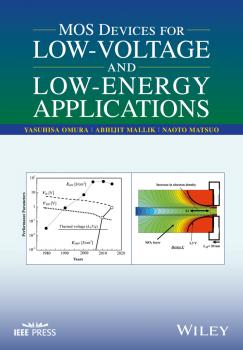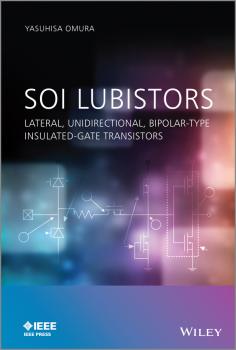ТОП просматриваемых книг сайта:
Yasuhisa Omura
Список книг автора Yasuhisa OmuraАннотация
Helps readers understand the physics behind MOS devices for low-voltage and low-energy applications Based on timely published and unpublished work written by expert authors Discusses various promising MOS devices applicable to low-energy environmental and biomedical uses Describes the physical effects (quantum, tunneling) of MOS devices Demonstrates the performance of devices, helping readers to choose right devices applicable to an industrial or consumer environment Addresses some Ge-based devices and other compound-material-based devices for high-frequency applications and future development of high performance devices. «Seemingly innocuous everyday devices such as smartphones, tablets and services such as on-line gaming or internet keyword searches consume vast amounts of energy. Even when in standby mode, all these devices consume energy. The upcoming 'Internet of Things' (IoT) is expected to deploy 60 billion electronic devices spread out in our homes, cars and cities. Britain is already consuming up to 16 per cent of all its power through internet use and this rate is doubling every four years. According to The UK's Daily Mail May (2015), if usage rates continue, all of Britain's power supply could be consumed by internet use in just 20 years. In 2013, U.S. data centers consumed an estimated 91 billion kilowatt-hours of electricity, corresponding to the power generated by seventeen 1000-megawatt nuclear power plants. Data center electricity consumption is projected to increase to roughly 140 billion kilowatt-hours annually by 2020, the equivalent annual output of 50 nuclear power plants.» —Natural Resources Defense Council, USA, Feb. 2015 All these examples stress the urgent need for developing electronic devices that consume as little energy as possible. The book “MOS Devices for Low-Voltage and Low-Energy Applications” explores the different transistor options that can be utilized to achieve that goal. It describes in detail the physics and performance of transistors that can be operated at low voltage and consume little power, such as subthreshold operation in bulk transistors, fully depleted SOI devices, tunnel FETs, multigate and gate-all-around MOSFETs. Examples of low-energy circuits making use of these devices are given as well. «The book MOS Devices for Low-Voltage and Low-Energy Applications is a good reference for graduate students, researchers, semiconductor and electrical engineers who will design the electronic systems of tomorrow.» —Dr. Jean-Pierre Colinge, Taiwan Semiconductor Manufacturing Company (TSMC) «The authors present a creative way to show how different MOS devices can be used for low-voltage and low-power applications. They start with Bulk MOSFET, following with SOI MOSFET, FinFET, gate-all-around MOSFET, Tunnel-FET and others. It is presented the physics behind the devices, models, simulations, experimental results and applications. This book is interesting for researchers, graduate and undergraduate students. The low-energy field is an important topic for integrated circuits in the future and none can stay out of this.» —Prof. Joao A. Martino, University of Sao Paulo, Brazil
Аннотация
Advanced level consolidation of the technology, physics and design aspects of silicon-on-insulator (SOI) lubistors No comprehensive description of the physics and possible applications of the Lubistor can be found in a single source even though the Lubistor is already being used in SOI LSIs. The book provides, for the first time, a comprehensive understanding of the physics of the Lubistor. The author argues that a clear understanding of the fundamental physics of the pn junction is essential to allowing scientists and engineers to propose new devices. Since 2001 IBM has been applying the Lubistor to commercial SOI LSIs (large scale integrated devices) used in PCs and game machines. It is a key device in that it provides electrostatic protection to the LSIs. The book explains the device modeling for such applications, and covers the recent analog circuit application of the voltage reference circuit. The author also reviews the physics and the modeling of ideal and non-ideal pn junctions through reconsideration of the Shockley’s theory, offering readers an opportunity to study the physics of pn junction. Pn-junction devices are already applied to the optical communication system as the light emitter and the receiver. Alternatively, optical signal modulators are proposed for coupling the Si optical waveguide with the pn-junction injector. The book also explores the photonic crystal physics and device applications of the Lubistor. Advanced level consolidation of the technology, physics and design aspects of silicon-on-insulator (SOI) lubistors Written by the inventor of the Lubistor, this volume describes the technology for readers to understand the physics and applications of the device First book devoted to the Lubistor transistor, presently being utilized in electrostatic discharge (ESD) applications in SOI technology, a growing market for semiconductor devices and advanced technologies Approaches the topic in a systematic manner, from physical theory, through to modelling, and finally circuit applications This is an advanced level book requiring knowledge of electrical and electronics engineering at graduate level. Contents includes: Concept of Ideal pn Junction/Proposal of Lateral, Unidirectional, Bipolar-Type Insulated-Gate Transistor (Lubistor)/ Noise Characteristics and Modeling of Lubistor/Negative Conductance Properties in Extremely Thin SOI Lubistors/ Two-Dimensionally Confined Injection Phenomena at Low Temperatures in Sub-10-nm-Thick SOI Lubistors/ Experimental Study of Two-Dimensional Confinement Effects on Reverse-Biased Current Characteristics of Ultra-Thin SOI Lubistors/ Gate-Controlled Bipolar Action in Ultra-thin Dynamic Threshold SOI MOSFET/Sub-Circuit Models of SOI Lubistors for Electrostatic Discharge Protection Circuit Design and Their Applications/A New Basic Element for Neural Logic Functions and Functionality in Circuit Applications/Possible Implementation of SOI Lubistors into Conventional Logic Circuits/Potentiality of Electro-Optic Modulator Based on SOI Waveguide/Principles of Parameter Extraction/Feasibility of Lubistor-Based Avalanche Photo Transistor


